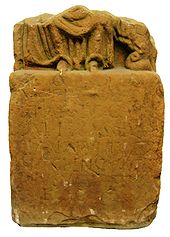Ritona
Ritona , also Pritona, was a Celtic goddess who was dedicated to a temple in the vicus Contiomagus ( Lachten , district of Dillingen / Saar ) and in the temple district in the Altbachtal in Augusta Treverorum ( Trier ). But a dedicatory inscription was also found for them in Uzès in the south of France .

Stone O.D. [e] t Pritonae Divinae sive Ca [---] ioni pro salute vikanorum Contiomagiensium Tertinius Modestus f (aciendum) c (uravit) v (otum) s (olvit)
The divine Pritona or Ca ... ioni for the salvation of the inhabitants of Contiomagus provided Tertinius Modestus with the production and redeemed a vow
etymology
Both spellings of the name - Ritona and Pritona - occurred among the Treverians in the Trier area . According to Helmut Birkhan , the sound development to ri took place here before the loss of p . The form Pritona (completely Dea Ritona Pritona ) has a preserved p , which is confusing. This is a double or translation name, whereby the second name is Celtic according to the vocalism, but the preserved p indicates an ethnic group that has only undergone part of the characteristic Celtic sound changes. Details about this ethnic group are unknown.
mythology
Ritona was a protective goddess of the watercourse and the ford ( -ritum "ford") through the Saar near Contiomagus. She is also seen as the deity of trade, because Olmsted reads the name variations as derivatives of Old Irish renaid ("sells") and crenaid ("buys"). However, this is not undisputed.
During excavation work on October 22, 1955, the Contiomagus stone (see right) was found. The sandstone block had apparently been removed from its original location and walled in as a foundation part in a corner tower of the Roman castle.
Whether there is a connection with the goddess Rotona has not been proven.
See also
literature
- Helmut Birkhan : Celts. Attempt at a complete representation of their culture. Publishing house of the Austrian Academy of Sciences, Vienna 1997, ISBN 3-7001-2609-3 .
Individual evidence
- ^ Edith Mary Wightman: Roman Trier and the Treveri. Rupert Hart-Davis, London 1970, ISBN 0-246-63980-6 , pp. 133 and 217.
- ↑ CIL XII, 02927 L (ucius) Gellius / Sentronis f (ilius) / Ritonae aede (!) / V (otum) s (olvit) l (ibens) m (erito)
- ^ AE 1959, 76 .
- ↑ Helmut Birkhan: Celts. Attempt at a complete representation of their culture. 1997, p. 60 and 285 f.
- ^ Garrett S. Olmsted: The Gods of the Celts and the Indo-Europeans. Archaeolingua Alapítvány, Budapest 1994, ISBN 3-85124-173-8 , p. 410.